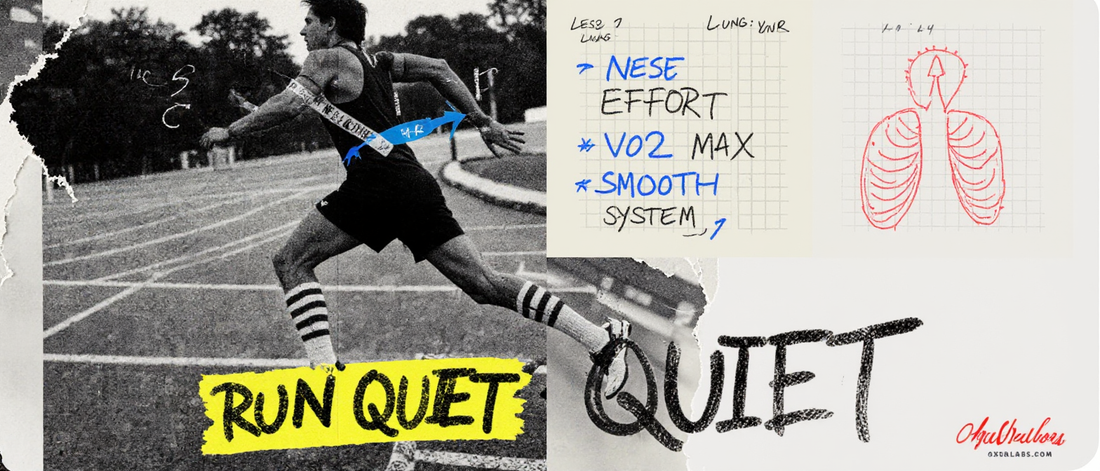
Run Quiet
Share
How nasal breathing trains your endurance, reduces effort, and smooths your whole system
You log your miles. Watch your splits. Maybe you even fuel with beet juice. But if you're breathing through your mouth the entire run, you're leaking performance-and probably finishing more wrecked than you need to be.
Nasal breathing isn’t just a recovery tool. It’s a performance enhancer.
Less effort. More oxygen. Better regulation.
Why Mouth Breathing Wrecks Running Efficiency
Mouth breathing during runs is common-but it’s not optimal.
-
You lose CO₂ too fast
→ Which sounds good… but isn't. CO₂ helps release oxygen into your muscles (Bohr effect). Without it, you’re breathing heavy with nothing to show for it. -
Your heart rate spikes early
→ Mouth breathing activates your fight-or-flight response. You hit redline faster. -
You waste energy ventilating
→ More breaths per minute = more work for your lungs = less energy for your legs. -
Your RPE increases
→ You feel like you’re working harder, even if your pace hasn’t changed. -
You burn sugar, not fat
→ Mouth breathing pushes you anaerobic faster-meaning you tap glycogen too soon and fatigue earlier.
What Nasal Breathing Does for Runners
1. Boosts VO₂ efficiency-not just capacity
Nasal breathing improves ventilatory economy. In one study, nasal-only runners hit the same VO₂ max as mouth breathers-but with a lower respiratory rate and lower perceived exertion. 1
→ Same ceiling. Better fuel economy.
2. Increases fat adaptation + lowers lactate load
Nasal breathing keeps you aerobic longer. That means:
-
More fat burning
-
Less lactate accumulation
-
Slower onset of fatigue
→ Fewer gels. More endurance.
3. Improves recovery on the run
By regulating your nervous system, nasal breathing keeps HR lower for the same pace. That means:
-
Less time in fight-or-flight
-
More time in flow
-
Faster recovery between intervals
→ You finish the workout fresher.
4. Lowers rate of perceived exertion (RPE)
Once your system adapts, running with nasal breathing feels smoother. More rhythm, less panic.
→ Effort goes down. Output stays up.
Will It Suck at First? Yes.
The first few nasal-only runs? Humbling. Your pace might slow. Your lungs will protest. But the adaptation curve is short-most runners feel a noticeable shift in 2–4 weeks.
Once it clicks, your breathing gets quieter. Your stride smooths out. Your heart rate steadies. And you realize: you were wasting energy before.
How to Train Nasal Breathing While Running
☑️ Start nasal during warmups
Walk briskly or do mobility work while nose-only breathing. Wake up the diaphragm.
☑️ Use +OXGN nasal strips
They lift the nasal valve-the tightest spot in your airway-for better airflow when effort increases.
☑️ Slow it down
Use easy runs to train nasal tolerance. Lower your pace. Build the pattern. Speed comes back later-with better economy.
☑️ Use tempo runs to test
Hold nasal-only as long as you can. Then shift to inhale-nose / exhale-mouth if needed.
→ Bonus: it builds CO₂ tolerance.
Nasal Breathing Is Quiet Power
The best runners look calm under pressure. Smooth. Efficient. In control. That doesn’t happen by chance. It’s breath training.
Mouth breathers gas out. Nasal breathers stay in the zone.
Up Next on the Blog
References
Dallam, G. M., et al. (2018). Effect of Nasal vs. Oral Breathing on Running Performance. Int J Exerc Sci. ↩